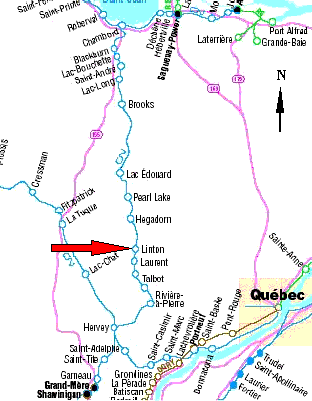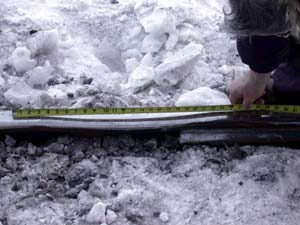Main-track derailment
Canadian National
Train M-369-21-17
Mile 62.4, Lac-Saint-Jean Subdivision
Linton, Quebec
The Transportation Safety Board of Canada (TSB) investigated this occurrence for the purpose of advancing transportation safety. It is not the function of the Board to assign fault or determine civil or criminal liability. This report is not created for use in the context of legal, disciplinary or other proceedings. See Ownership and use of content. Masculine pronouns and position titles may be used to signify all genders to comply with the Canadian Transportation Accident Investigation and Safety Board Act (S.C. 1989, c. 3).
Summary
On 17 March 2004, at approximately 1340 eastern standard time, Canadian National train M-369-21-17 was southbound en route to Garneau, Quebec, when 22 cars derailed at Mile 62.4 of the Lac-Saint-Jean Subdivision near Linton, Quebec. Eighteen cars were destroyed, four cars were damaged, and approximately 140 metres of track was destroyed. There were no injuries and no dangerous goods were spilled.
Ce rapport est également disponible en français.
Factual information
Canadian National (CN) train M-369-21-17 departed Chambord, Quebec, bound for Garneau, Quebec. It consisted of 4 locomotives and 66 cars, including 56 loaded cars and 10 empties. It was approximately 4060 feet long and weighed about 6960 tons. The train crew consisted of a locomotive engineer and a conductor. Both were qualified for their respective positions and met rest and fitness requirements.
At Mile 62.4, near Linton, Quebec (see Figure 1), the train experienced an undesired emergency brake application. The train crew followed emergency procedures. The conductor inspected the train and found that 22 cars (the 28th to the 49th cars) had derailed while exiting a left-hand curve in the direction of movement. The weather was clear and the temperature was -3°C.
The data from the event recorder on the lead locomotive showed that the train had been travelling at 30 mph and that the throttle had been moved gradually from the No. 3 position to the neutral position. The emergency brake application had been initiated from the train.
The Lac-Saint-Jean Subdivision extends from Garneau (Mile 0.0) to Arvida (Mile 203.5), and consists of a single main track. Train movements are governed by the Occupancy Control System in accordance with the Canadian Rail Operating Rules, and are supervised by a rail traffic controller based in Montréal, Quebec. The track is Class 3 according to Transport Canada's Railway Track Safety Rules (TSR). The maximum speed is 40 mph for passenger trains and 30 mph for freight trains. The maximum authorized freight car weight is 286 000 pounds, and the annual tonnage is approximately eight million tons.
The first derailed car (the 28th) was flat car CN 618220. It was loaded with aluminum ingots and weighed 282 000 pounds, or 35 250 pounds per axle; it was the heaviest car in the train. It remained coupled to the forward part of the train, but its trailing end was on the embankment along the Batiscan River on the west side of the track. The following cars uncoupled and descended the track embankment, coming to rest on the river bank.
Throughout the subdivision, the track consists mainly of 115-pound continuous welded rail. There are 3200 ties per mile of track. The tie plates are double-shouldered and secured to the ties with six spikes per tie. The rail is box-anchored every third tie. As a result of repeated track work in the occurrence area, the west rail (on the outside of the curve) was made up of several lengths of jointed rail that came from different sources, and were rolled and laid on different dates. According to CN's Standard Practice Circulars (SPCs) and the TSR, the rails for Class 3 tracks carrying passenger trains are inspected and the track geometry is checked at least once a year.
On the Lac-Saint-Jean Subdivision, the rails are ultrasonically tested for internal defects four times a year. The last rail inspection in the area of the derailment was done on 20 December 2003 and revealed no defects. On that inspection, several sections of rail could not be inspected due to a heavy snowfall. On other internal inspections and visual examinations of the rails in 2003, six vertical split heads ranging in length from 50 inches to 120 inches were detected in the west rail of the curve.
Track geometry is checked three times a year by the track geometry car. On the last two verifications, a wide gauge in the curve starting at Mile 62.40 was discovered. On 22 September 2003, the wide gauge was 1 ½ inches and exceeded the limits prescribed in the TSR. Track speed was reduced to 10 mph until the track was repaired on 15 November 2003. The track foreman who conducted the last visual inspection, from a hi-rail vehicle on 14 March 2004, noted no rail defects.
At about Mile 62.40, where the track destruction started, the west rail was broken under the last derailed car. The fracture occurred in a section of jointed rail 39 feet long. Examination of the pieces of rail revealed a vertical split head on the inside of the rail extending over a length of 600 mm. The fracture surface was heavily oxidized, indicating that it had been there for some time. It is highly probable that the rail failed under car CN 618220, which had the highest per-axle weight in the train, including the locomotives.
The rail was rolled in 1952, but there is no documentation indicating where it came from or when it was laid. Vertical rail wear was 9 mm and lateral wear was 5 mm, exceeding the wear limits prescribed by SPC 3200 for jointed rail, which are 8 mm for vertical wear and 13 mm for combined (lateral and vertical) wear. The rail had a crushed head (see Photo 1) 10 mm in depth located 410 mm from the north rail joint and about 1 m from the rail fracture.
The crushed rail head was not noted in the bi-weekly inspection records. The TSR do not define a crushed rail head as a defect. It is considered a defect in SPC 3207 when the depth reaches 10 mm, but no corrective action is required.
No wheel flange or dragging equipment marks were found north of the broken rail. The wide gauge immediately to the north of this point was one inch. Examination of the cars revealed no mechanical defects before the accident. Further, no jarring or abnormal movement was felt when the locomotives went over this spot.
The basic factors affecting rail fatigue are the number of loading cycles (accumulated tonnage), their severity (stress magnitude) and the presence of a stress raiser (cleanliness). Since there is no documentation indicating where the rail came from or when it was laid, the accumulated tonnage is not known. The age and wear of the rail would most likely indicate a high accumulated tonnage. Also, the presence of the crushed rail head and the several sections of rail installed in the curve would suggest that the rail section was subject to recurrent failures. Therefore, it is reasonable to state that the fatigue resistance of the rail was exhausted.
Findings
Findings as to causes and contributing factors
- The west rail failed suddenly as the 28th car in the train rolled over it, causing the train to derail.
- The failure progressed from a vertical split head on the inside of the rail.
- The age and wear of the rail and the presence of the crushed rail head suggest that the fatigue resistance of this section of rail was exhausted.
Findings as to risks
- Despite the frequency of ultrasonic rail tests and special visual rail inspections, the relatively high number of rail defects found in the curve indicates that fatigue resistance was reduced, creating additional risks of failure.
- The wide gauge in the curve is recurrent despite frequent corrective actions, and can consequently present a risk to safe train operation.
Other findings
- The fracture surfaces of the rail were discoloured and oxidized, indicating that the cracks had been present for some time.
Safety action taken
CN has increased the frequency of the visual inspection from twice a week to three times a week. SPC 3207 has been amended; it now includes criteria for remedial action for crushed rail heads.
This report concludes the Transportation Safety Board's investigation into this occurrence. Consequently, the Board authorized the release of this report on .

